1994 CADILLAC ELDORADO ESP
[x] Cancel search: ESPPage 31 of 398
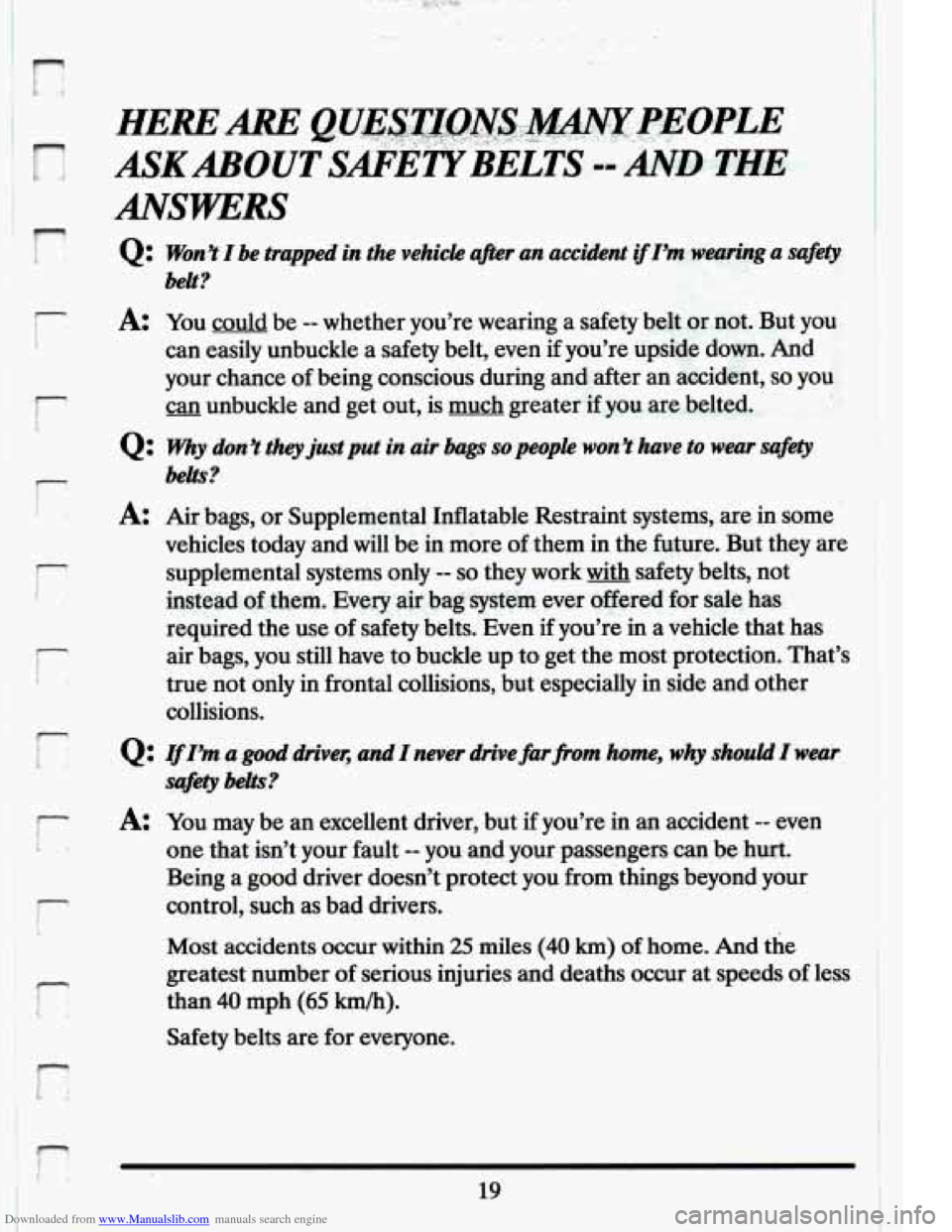
Downloaded from www.Manualslib.com manuals search engine r
r
1.
r.
r
I-- t
1
I
tl
HE',m &u&'S:WNSzM I . ,+ .~~ .-I,.*v .. I ~.~., jk ,.:..*.. -'".-> .& b. .':..-' .I. - 'qr.,.'. PEOPLE i_.i> :..
ASKABOUT S'ETyBE'Ts MD -THE
ANSWERS
Q: Won't I be trapped in the vehicle afler an accident ifIh wearing a safety
belt? #<
k You could be -- whether you're wearing a safety belt or not. But you"
,A'
can easily unbuckle a safety belt, even if you're upside down. And
your chance of being conscious during and after an accident,
so you
can unbuckle and get out, is much greater if you are belted.
I Q : Why don't they just put in air bags so people won't have to wear safe0
belts?
k Air bags, or Supplemental Inflatable Restraint systems, are in some
vehicles today and will be in more of them in the future. But they are
supplemental systems only
-- so they work with safety belts, not
instead
of them. Every air bag.system ever offered for sale has
required the use of safety belts. Even if you're in a vehicle that has
air bags, you still have to buckle up to get the most protection. That's
true not only in frontal collisions, but especially in side and other
collisions.
Q: IfI'm a good driver, andIraever drive farporn home, why should I wear
safety
beb?
k You may be an excellent .driver, but if you're in an accident -- even
one that isn't your fault -- you and your passengerscan be hurt.
Being a good driver doesn't protect
you from things beyond your
cqntrol, such as bad drivers.
Most accidents occur within
25 miles (40 km) of home. And the
greatest number of serious injuries
and deaths occur at speeds of less
than
40 mph (65 km/h).
Safety belts are for everyone.
19
Page 117 of 398
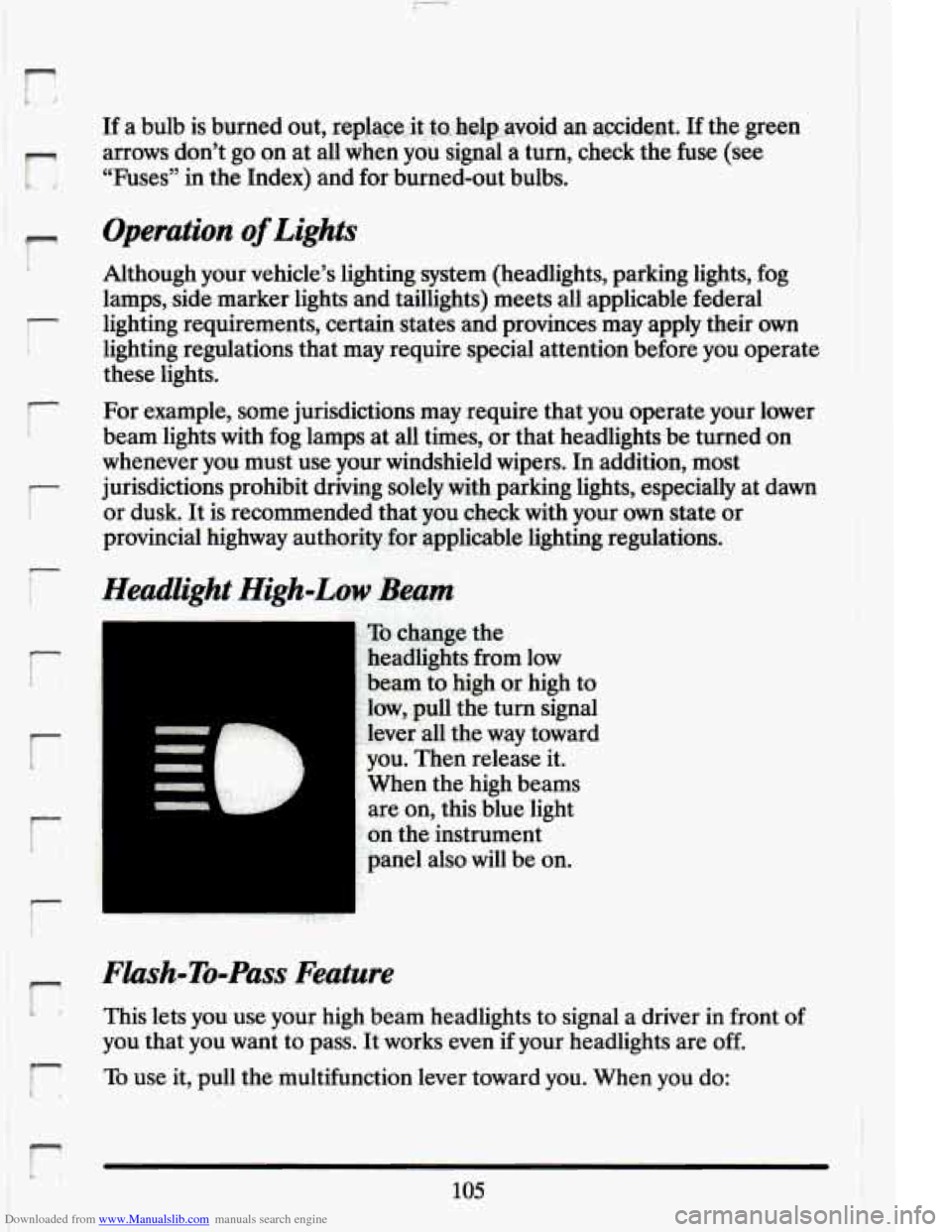
Downloaded from www.Manualslib.com manuals search engine r
r
!-
r
r
lr
If a bulb is burned out, ~~p~a~~~,~~.~~~.h~~~~a~~~~-an ,?wide$. If the green
arrows don’t
go on at all when you signal-a turn, check the fuse (see
“Fuses” in the Index) and for burned-out bulbs.
Operation of Lights
Although your vehicle’s lighting system (headlights, parking \
lights, fog
lamps, side marker lights and taillights) meets all applicable federal
lighting requirements, certain states and provinces may apply their
own
lighting regulations that may require special attention before you operate
these lights.
For example, some jurisdictions may require that you operate your lower
beam lights with fog lamps at all times, or that headlights be turned on
whenever you must use your windshield wipers. In addition, most
jurisdictions prohibit driving solely with parking lights, especially at dawn
or dusk. It is recommended that you check with your
own state or
provincial highway authoritfi for applicable lighting regulations.
Headlight High-Low Beam
To change the
headlights from low
‘beam to high or high to
low,
pull the turn signal
lever all the way toward
you. Then release it.
When the high beams
are on, this blue light
on the instrument
panel also will be on.
Flash-To-Pass Feature
This lets you use your high beam headlights to signal a driver in front of
you that you want to pass. It works even if your headlights are off.
To use it, pull the multifunction lever toward you. When you do:
105
Page 159 of 398

Downloaded from www.Manualslib.com manuals search engine TRANSFLUJJlRESET=48. .2. .. .. 1 ., . _,,. . :A -. v-. . .. .. , .- .
With the engine not running and the ignition ON, press and hold the
OFF and REAR DEFOG buttons until the TRANS FLUID'RESET
message appears in the Information Center (between 5 and 20 seconds).
TURN SIGNAL ON. - 20
This message is a reminder, after driving about a mile, that you have your
turn signal on.
TRUNK OPEN - 24
k
r
f
I
I
f L,
P
F
r
r
Speed Sensitive Steering (11 5s)
This system varies the amount of steering effort proportiabate to
your vehicle speed. Steering
is eesier at a lower speed for increased
maneuverability and parking ease.
As your vehicle speed increases, the'"-:
steering effort is also increased proportionately. At highway speeds the
amount
of steering effort is increased to provide a manual like steering
feel for maximum control and enhanced vehicle stability.
. ./ ; .
.. ..
Road Sensing Suspension
The Road Sensing Suspension automatically controls the ride of your
vehicle. The system controls damping
forces in the shock absorbers and
struts
in response to various road and driving conditions. The system is
capable
of making these changes within milli-seconds.
The Road Sensing Suspension controller is a computer used to control and
monitor the system. The computer receives inputs from vertical acceleration
sensors, wheel to body position sensors, vehicle speed sensor, lift and dive
signals,
and determines optimum strut valving or (suspension stiffness) for
your current operating conditions. The computer a1,so receives feedback
Page 169 of 398
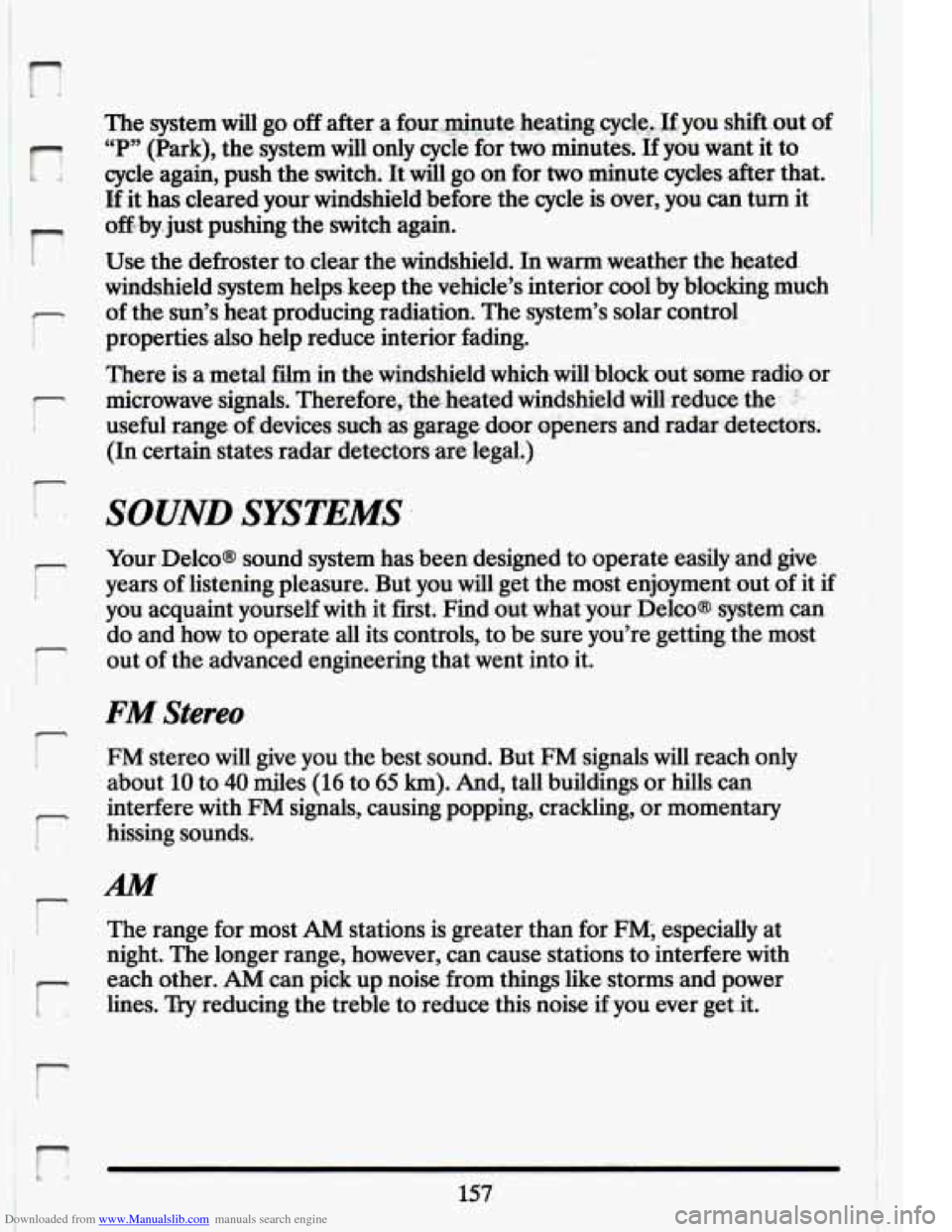
Downloaded from www.Manualslib.com manuals search engine n
m
The system will go off after a fmr,.g&u$e: h~e~~i~~~.c;vc!e,I~~you shift.out of
“P” (Park),, the system will only cycle for two minutes. If you want it to
cycle again, push the switch. It.wil1 go on for two minute cycles. after that.
If it has cleared your windshield before the cycle is over, you can turn it
off.by.just gushing the switch again.
1 Use. the defroster ta.clear the windshield. In warm weather the heated
- of the sun’s heat.producing radiation. The system’s solar control
windshield system helps.
keep the vehicle’s interior cool by blocking much
I properties also help reduce interior fading.
There is a metal
film in: the windshield- which. will%lockout some radio or
r microwave signals. Therefore,
(In certain states radar detectors ardegal:)
Your.Delco@ sound system has been .designed to operate easily and
give.
you acquaint yourself with it first. Find out whatyour Delcoa system can
do .and how
to operate all its controls, to be. sure you’re getting the most
r years of listening pleasure. But you will get the most enjoyment out. of .it if
i out of the advanced engineering that went into it.
FM Stereo
m
I FM stereo will give you the best sound. But FM signals will reach only
about
10 to 40 miles (16 to 65 km). And, tall buildings or hills can
interfere with
FM signals, causing popping,. crackling, or momentary
1 r hissing sounds.
I
AM
r I
1
The range formost AM stations is greater than for FM; especially at
night. The longer range, however, can cause stations to interfere with
.,
each other. AM can pick up noise from things like storms and power
r lines. Tiy reducing the treble to reduce this noise if you ever get .it.
t
157.
Page 174 of 398
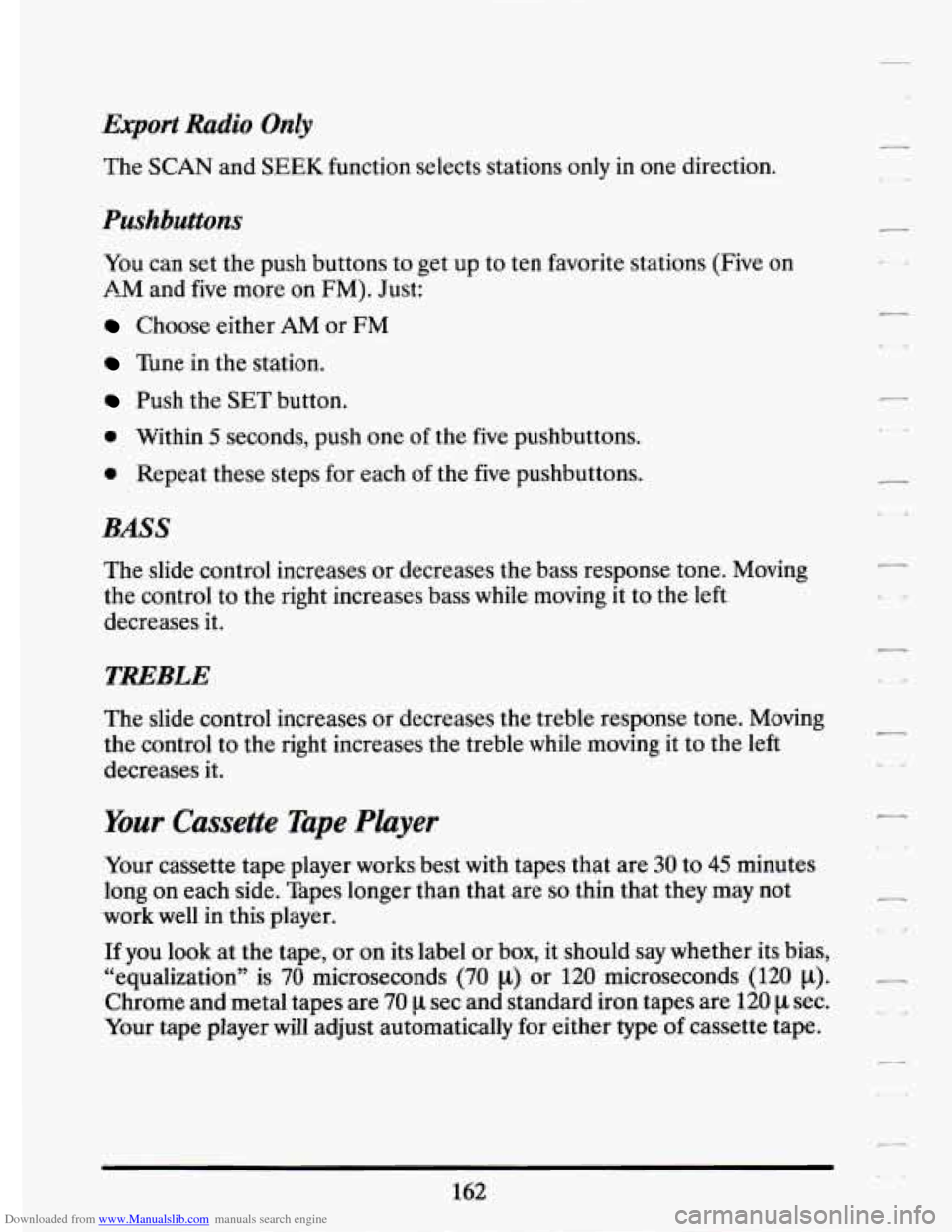
Downloaded from www.Manualslib.com manuals search engine Export Radio Only
The SCAN and SEEK function selects stations only in one direction.
Pushbuttons
You can set the push buttons to get up to ten favorite stations (Five on
AM and five more on FM). Just:
Choose either AM or FM
Tune in the station.
Push the SET button.
0 Within 5 seconds, push one of the five pushbuttons.
0 Repeat these steps for each of the five pushbuttons.
BASS
The slide control increases or decreases the bass response tone. Moving
the control to the right increases bass while moving it to the left
decreases it.
TREBLE
The slide control increases or decreases the treble response tone. Moving
the control to the right increases the treble while moving it to the left
decreases it.
Your Cassette Tape Phyer
Your cassette tape player works best with tapes that are 30 to 45 minutes
long on each side. Tapes longer than that are
so thin that they may not
work well in this player.
If you look at the tape, or on its label or box, it should say whether its bias,
“equalization” is
70 microseconds (70 p) or 120 microseconds (120 p).
Chrome and metal tapes are 70 p sec and standard iron tapes are 120 p sec.
Your tape player will adjust automatically for either
type of cassette tape.
162
Page 186 of 398
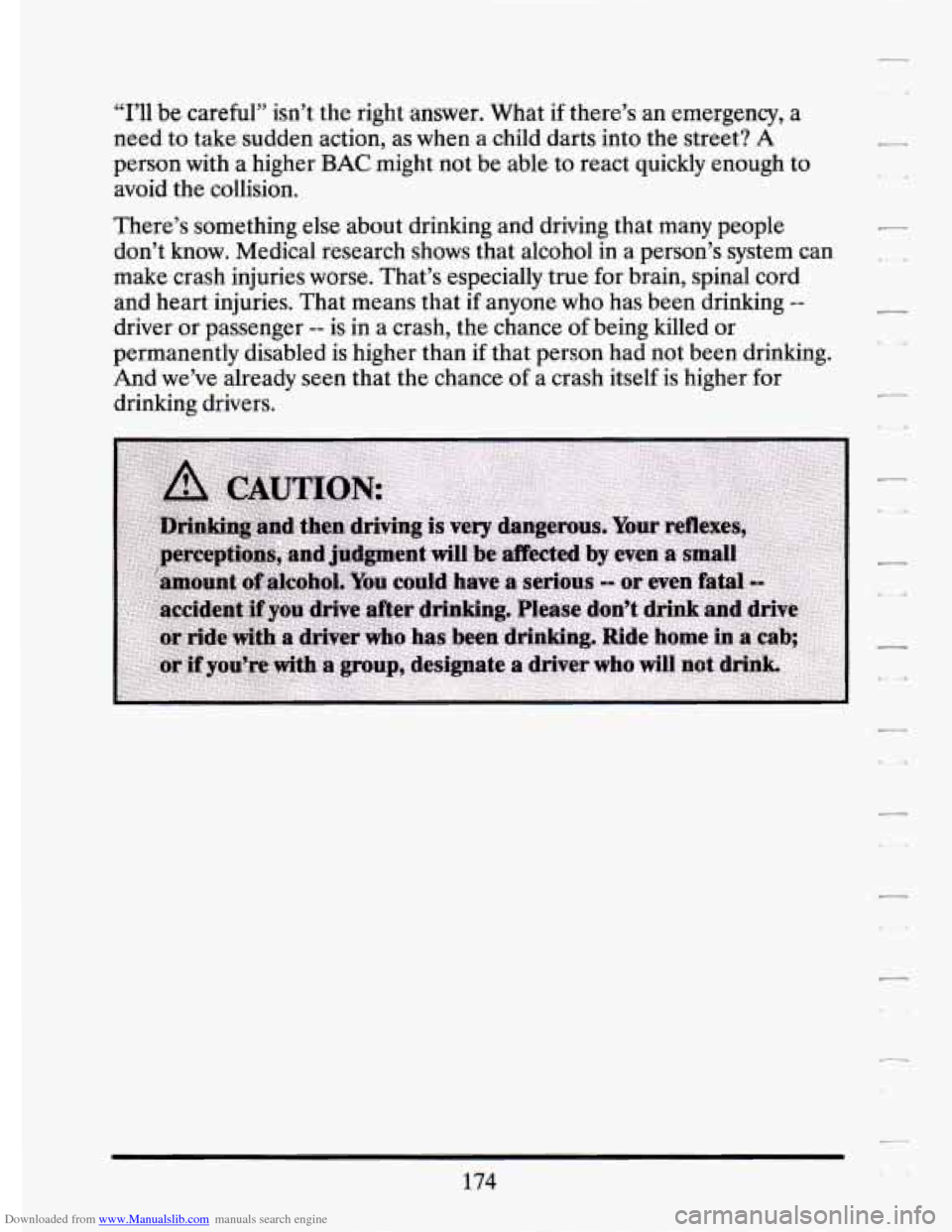
Downloaded from www.Manualslib.com manuals search engine “I’ll be careful” isn’t the right answer. What if there’s an emergency, a
need to take sudden action, as when a child darts into the street? A
person with a higher BAC might not be able to react quickly enough to
avoid the collision.
There’s something else about drinking and driving that many people
7
don’t know. Medical research shows that alcohol in a person’s system can
make crash injuries worse. That’s especially true for brain, spinal cord
and heart injuries. That means that
if anyone who has been drinking --
driver or passenger -- is in a crash, the chance of being killed or
permanently disabled is higher than if that person had not been drinking.
And we’ve already seen that the chance of a crash itself is higher for
drinking drivers.
Page 191 of 398
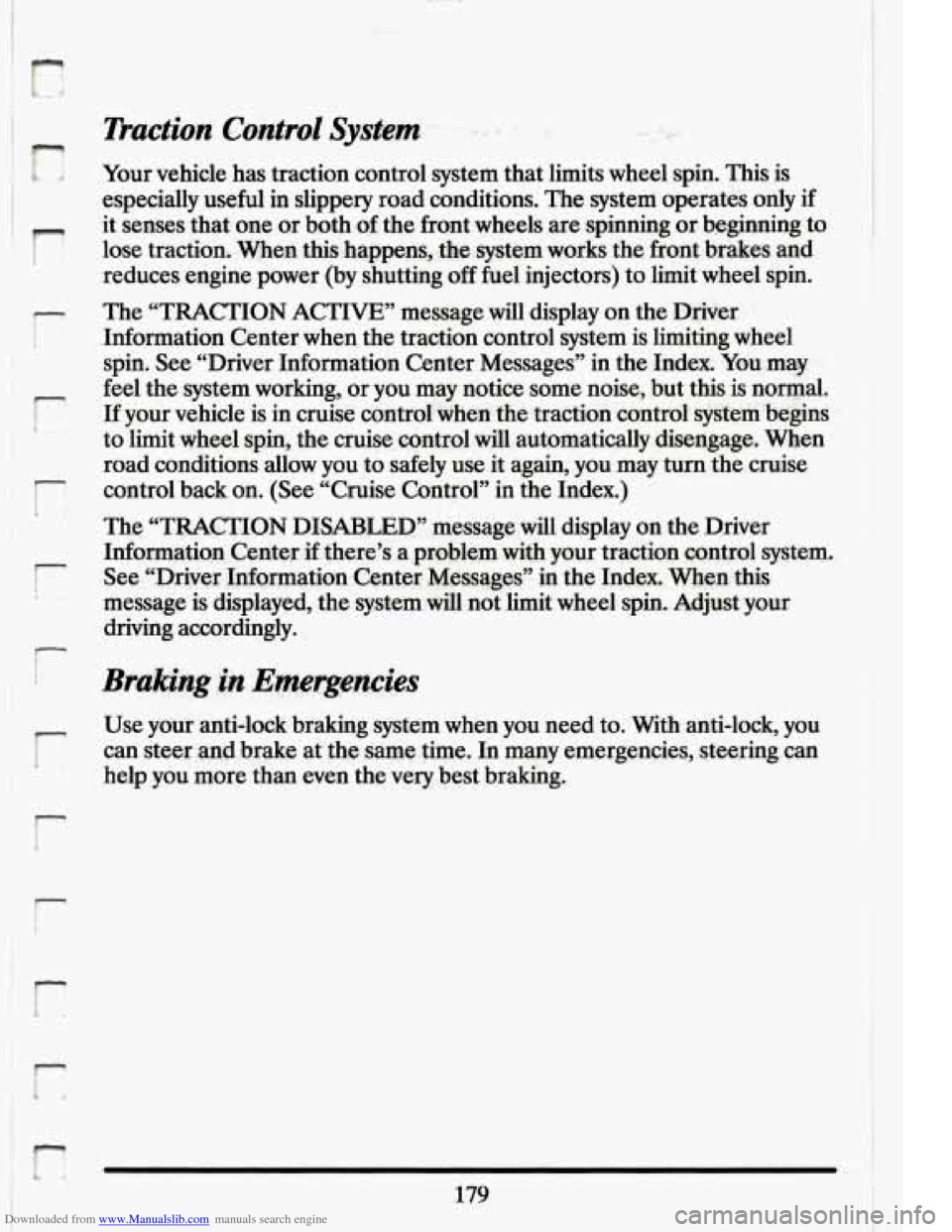
Downloaded from www.Manualslib.com manuals search engine I
r
i .’
r
r
L
r
i
r I
Your vehicle has traction control system that limits wheel spin. This is
especially useful in slippery road conditions. The system operates only
if
it senses that one or both of the front wheels are spinning or- beginning to
lose traction. When .this happens, the system works the front brakes and
reduces engine power (by shutting
off fuel injectors) to limit wheel spin.
The “TRACTION ACTIVE” message will display on the Driver
Information Center when the traction control system is limiting wheel
spin. See “Driver Information Center Messages” in the Index. You may
feel the system working, or you may notice some noise, but this
is nomal.
If your vehicle is in cruise control when the traction control system begins
to limit wheel spin, the cruise control will automatically disengage. When
road conditions allow you to safely use it again, you may
turn the cruise
control back on. (See “Cruise Control” in the Index.)
The “TRACTION DISABLED” message
will display on the Driver
Information Center
if there’s a problem with your traction control system.
See “D,river Information Center Messages” in the Index. When. this
message is displayed, the system will not limit wheel spin. Adjust your
driving accordingly.
Braking in Emergencies
Use your anti-lock braking system when you need to. With anti-lock, you
can steer and brake at the same time. In many emergencies, steering can
help you more than even the very best braking.
179
Page 195 of 398
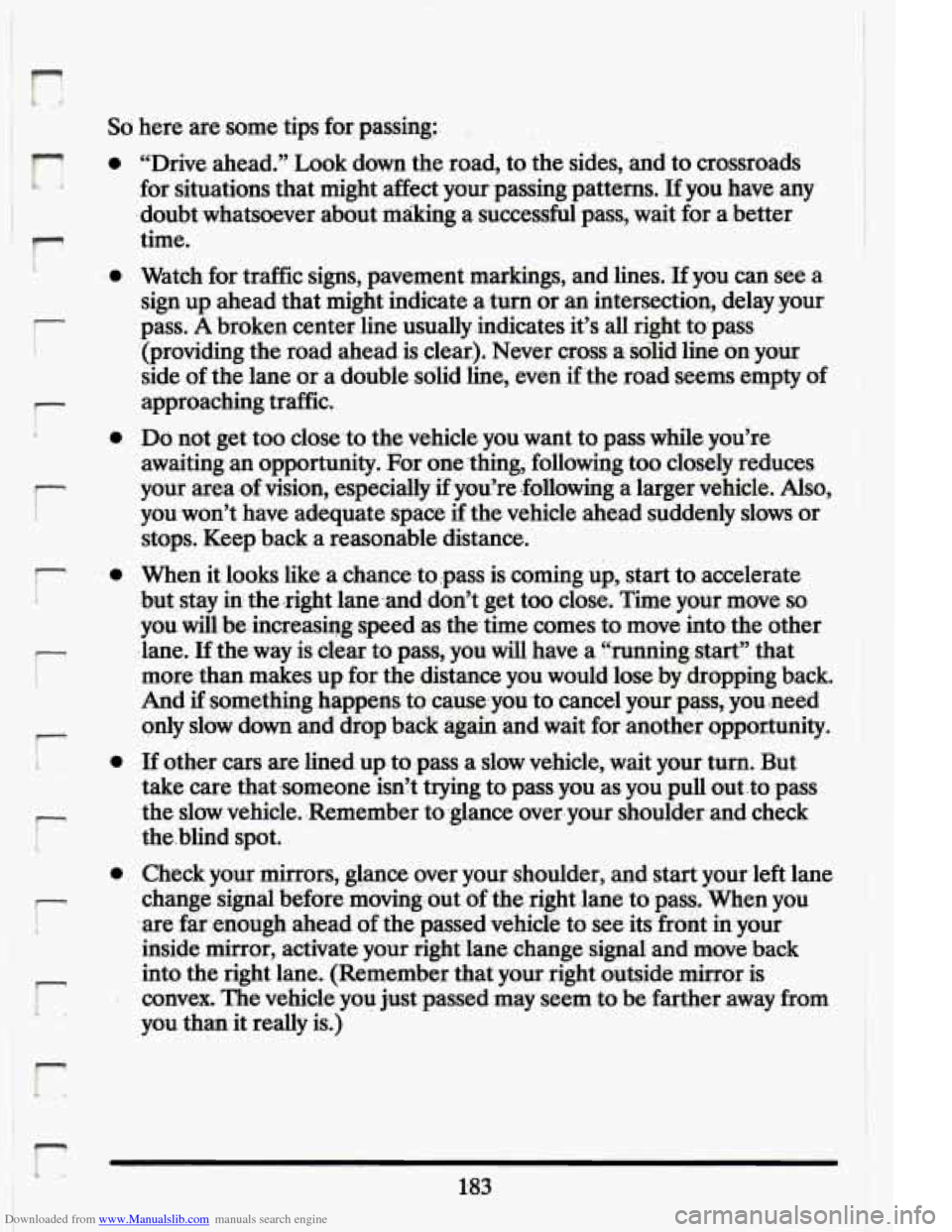
Downloaded from www.Manualslib.com manuals search engine So here are some tips for passing: . .
r I
r
0
0
0
0
r
F
0
F i
0
c
r
“Drive. ahead.” Look down the road, to the sides, and to crossroads
.for situations that might affect your passing patterns.
If you have any
doubt ,whatsoever about making a successful. pass, wait for a.better
time.
.Watch- for traffic signs, pavement markings, and lines.
’If you can see .a
sign up ahead that might indicate a turn or an intersection, delay your
pass.
A broken center line usually .indicates it’s all right to pass
‘(providing the road ahead isclear.):Never cross
a solid line on your
side
of the lane or a double solid line, even if ‘the road. seems empty of
approaching traffic.
Do not :get
too closelo the,vehicle you want.to pass while you’re
awaiting- an opportunity. For .one lthmg, following too closely reduces
your
area ,of vision, especially if you’re .following a ‘larger vehicle. Also,
you-won’t have adequate space if the vehicle ahe:ad suddenly slows or
stops. Keep back a reasonable distance.
When it looks like a .chance: to ,pass
is coming. up, start to. accelerate
.but stay in the.right 1ane.and.don’t.get too dose. Time your move
so
.you wiIl.be .increasing speed as the time comes to move into the other
.lane.
If the way is clear to pass, you will have a .‘‘running, start” that
more than makes up for the distance you would lose
by .dropping back.
And
if something happensto.cause:youto cancel your pass, you need I
only slow down and drop back again and wait for another opportunity.
-If other cars are 1ined.u~ to pass a slow vehicle, wait your turn. But
take care that someone isn’t trying
to pass you as you:,pull outto pass
the slow vehicle. -Remember
to ‘glance over. your shoulder-and check
theblind spot.
Check your mirrors, glance over your shoulder, and start your left lane
change signal before moving.out
of the right .lane to pass,. When you
:are far:enough ahead
of ,the passed vehicle to see its front in. your
inside mirror, activate your right. lane change signal
and move back I
into the right lane. (Remember that your right outside mirror is
convex.
The vehicle you just passed may seem to be farther away from
you than itreally is.)
!,, 1 - ’ - ,- . ..
183